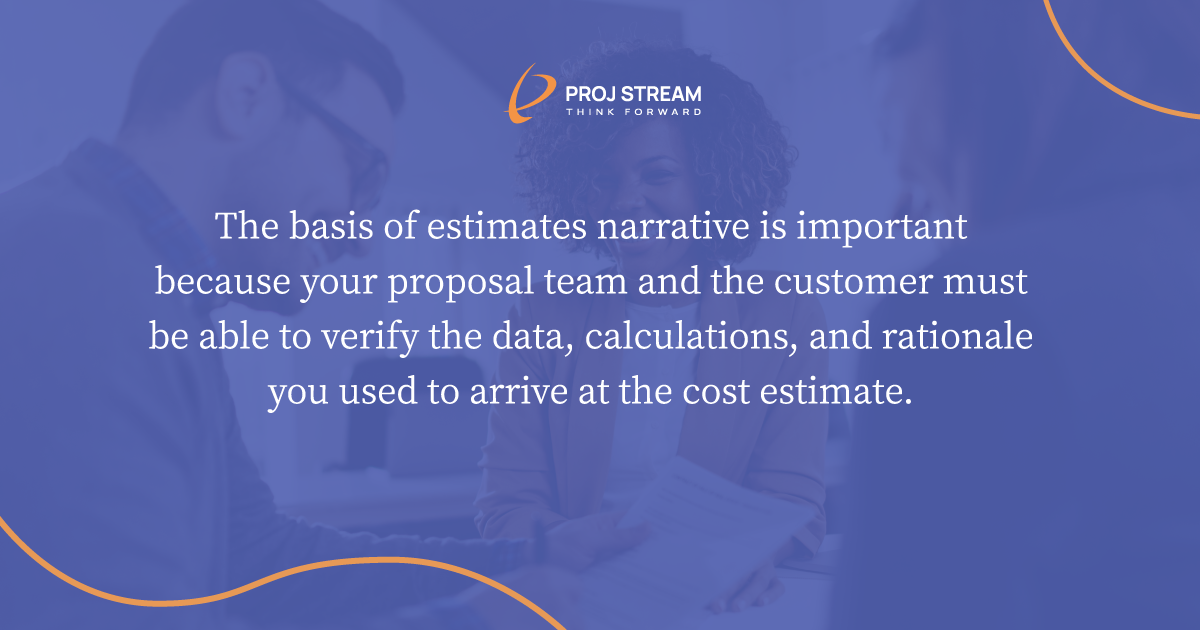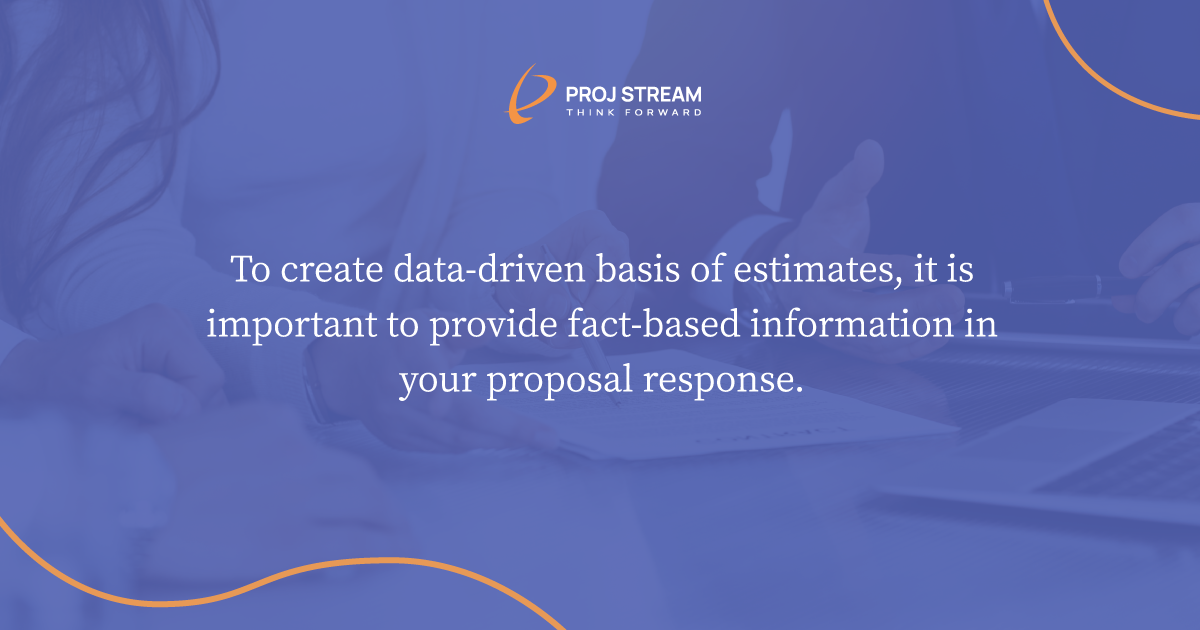A basis of estimate (BOE) is an organized set of data and narrative information that explains the logic, methodology, calculations, and assumptions you use to define the tasks and determine the resources needed to accomplish the scope of work described in a government or other request for proposal (RFP). It provides data and narrative information that can be used to determine the ability of the bidding contractor to carry out the project.
Developing a credible BOE requires reliable historical and actual cost source data that you can trace back to the applicable business system, such as accounting, purchasing, material management, manufacturing, or time keeping. The BOE narrative is important because your proposal team and the customer must be able to verify the data, calculations, and rationale you used to arrive at the cost estimate.
To create data driven basis of estimates, it is important to provide fact-based information in your proposal response.
This makes it easier for your government customer to verify you have:
- Understood the RFP scope of work, technical requirements, and deliverables.
- Defined the sequence of tasks to meet the RFP’s technical requirements and deliverables.
- Identified the necessary resources – whether labor, material, travel, outside services or suppliers, and other direct costs to accomplish the tasks.
- Selected an appropriate estimating methodology for the tasks along with applicable narrative information so someone else can follow your thought process.
- Produced a realistic cost estimate.
Two important ingredients for producing a credible basis of estimate include selecting the appropriate estimating methodology and accessing verifiable source data from your business systems.
Government contract proposal writers often lean on one of these four important estimating methodologies. Let’s take a high-level overview of each, along with what data and narrative information you need to produce your basis of estimate.
Analogous Methodology
This method often works well for proposals that include development work effort where some aspects of the project are not yet fully defined. You may have performed similar work effort that can serve as the basis to calculate a likely cost estimate.
For this estimating method, you will need the historical actual hours and cost data from another project or set of completed tasks that are similar to the tasks in your proposal. You may want to apply complexity or other factors to account for any work scope, technical, resource, or other differences.
In your cost estimate narrative, include details about how you arrived at your cost estimate such as:
- The source of the historical analogous data;
- Why you think the analogous data are relevant;
- Differences between the analogous data and the proposal requirements; and
- The factors you applied.
Cost Estimating Relationship (CER) Methodology
This method works well when you frequently perform similar work effort and you have established a library of statistically valid cost estimating relationships using historical data to support linear regression for parametric analysis. Parametric types are unique to your business environment. You could also use CER data provided from other organizations. If you do use data from another organization, be sure to note the source of the data.
In your cost estimate narrative, include details such as:
- The base or independent variable you used such as lines of code to determine the number of labor hours required;
- Information about the source data and relevant statistics such as mean and standard deviation of independent variables, number of data points, and range of data;
- The equation, input variables, and calculated output value; and
- Any adjustments you made to the output value and why you made those adjustments.
Task Based or Bottoms Up Methodology
This method also works well when you frequently perform similar work effort and can access a library of historical performance data or you use a set of standards for accomplishing comparable tasks. You often need to work with other technical experts in your company, such as a design engineer, to calculate labor hours from known factors such as engineering drawings or specifications. There may be related material and purchased parts requirements.
In your cost estimate data as well as narrative, include details such as:
- Historical or other basis for the estimate and whether any work standards were applied;
- Methods used to determine the cost of materials or purchased parts;
- Bills of material including which items apply to which elements of work; and
- Basis of pricing for material items and why a specific supplier was selected.
Level of Effort (LOE) Methodology
There is usually some level of support tasks that are required for a project such as allocating hours for project management, quality assurance, or supervisory personnel. You use the LOE methodology for these support tasks. The support services often vary depending on the type of work, complexity, contract type, or other factors. You may have an established set of standards such as a percentage of labor hours to support specific types of tasks. In the cost estimate narrative, include details such as:
- The basis for determining the allocations for support services;
- Which tasks are included in the allocation; and
- Rationale for the period of performance for the support services – this may be based on specific tasks.
Engineering Judgment Methodology
This is the least desirable cost estimating methodology because you are relying on the expertise and rationale of one or more technical resources. You don’t have relevant historical actual hours or costs you can use to independently verify the cost estimate they develop is realistic. The technical expert develops the estimate usually at the lowest level of the work breakdown structure (WBS) based on the statement of work, specifications, drawings, or other details the customer may have provided. This is where the content of the cost estimate narrative is critical.
The technical expert needs to provide sufficient detail so someone else can verify their:
- Thought process and any source data they used with detailed explanations;
- What calculations they used, rationale, and assumptions; and
- Qualifications to provide a realistic cost estimate.
Interested in Learning More About Cost Estimating Methodologies?
Cost estimating is both an art and a science. The International Cost Estimating and Analysis Association (ICEAA) is dedicated to furthering the profession. ICEAA provides publications, webinars, and certifications to help cost estimators hone their craft. They sponsor an annual workshop and maintain chapters that plan training workshops, networking events, and other meetings throughout the year.
The Right Cost Estimating Software Can Help
Cost estimating is arguably the most critical and challenging part of creating a proposal response, but the right software can make a big difference. For example, during our work with clients, we have uncovered that for many, Excel is the tool used to create proposal cost estimates (and even for project cost management in the execution phase.) Use of multiple programs, cut-and-paste data compilations, and unsynced data sources can lead to time-consuming –and error-prone– outcomes.
Cost estimating software tools such as ProjStream’s BOEMax can make a difference because you can create data driven basis of estimates easier and faster, greatly decreasing the time it takes to create and iterate proposals.
With BOEMax integrated cost estimating and pricing software, you can:
- Maintain a single database of historical proposal cost estimates as well as actual hours and cost source data you can search and copy into your proposal project to substantiate your BOE.
- Maintain a process library of standard or common tasks. These are templates of reusable engineering or manufacturing processes that include the applicable bills of material and related labor requirements (skill mix and hours) required to produce an output. You select the applicable tasks and apply quantity or complexity factors when you copy them into your proposal project. Once again, you have reliable source data to substantiate your BOE.
- Maintain a library of cost estimating relationship historical data for parametric estimating.
- Maintain a master part and assembly list so you can quickly build hierarchical bills of material for your proposal project from reliable source data.
- Identify resource allocations for common support services.
- Combine the cost estimate data with the built-in rich text documentation all in the same database to easily produce standard cost summary reports required for responding to government RFPs.
Using ProjStream’s tools helped to reduce a large military defense organization’s proposal iteration time by 90%. Change requests that once took 30 days now take an average of only three.
The contractor’s vice president of business development noted, “We now consider this portion of the RFP response phase a competitive advantage because we can save our starting point, make logical batch changes based on scope or rate changes and then compare the deltas using project version reporting. Things that used to take us days now take hours to complete….The benefits of an integrated BOE, scheduling and pricing tool has been a much more efficient use of our B&P (bid and proposal) funds and resources.”
Call us today to schedule a demo of BOEMax basis of estimate software or explore ProjStream’s integrated set of software tools for an end-to-end solution for both proposal and project cost management using a single database design. See for yourself the difference ProjStream’s solution can make in the quality of your cost estimates and your proposal process.
Updated January 17, 2022




